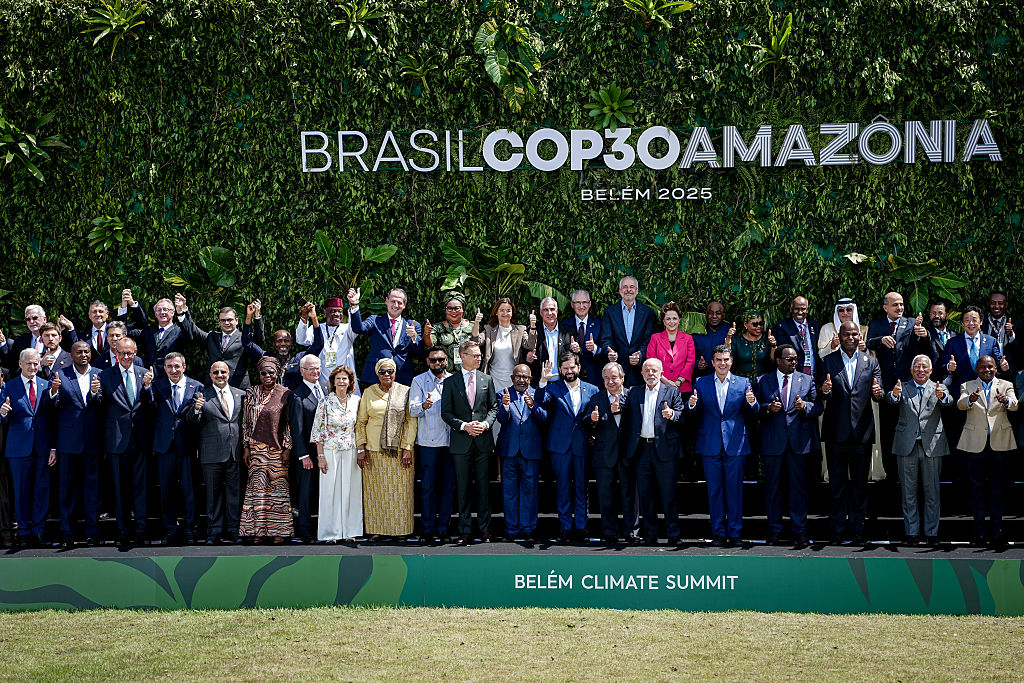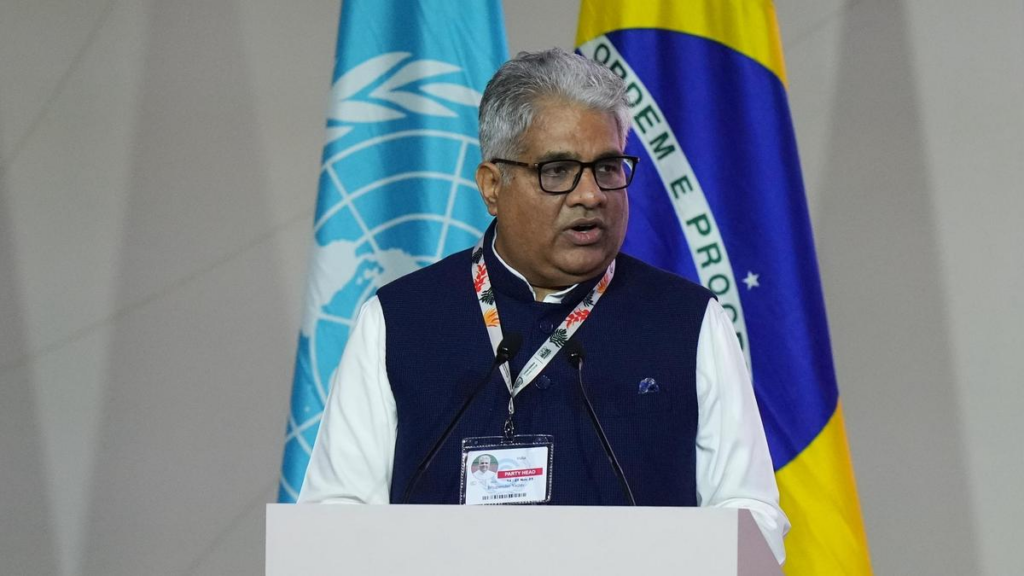
- At COP30, India presented a proposal focused on increasing financial support for climate action, strengthening adaptation, and applying the principle of common but differentiated responsibilities.
- India, a member of the Like-Minded Developing Countries (LMDC) group, has consistently resisted proposals requiring a mandatory phase-out of fossil fuels, emphasising that energy transitions should consider national circumstances, balancing fossil fuel usage with welfare initiatives and energy security.
- India joined the South-South Collective for Climate, supported by climate-tech innovators from Brazil and India, to assist more than 5,000 climate start-ups by 2030.
- The COP30 summit in Belém marked a pivotal moment for global climate action and for India’s evolving role. India’s nuanced stance of advocating for climate justice while rejecting phase-out deadlines was indicative of the complexity of an economy that is both emerging and significant.
The 30th Conference of the Parties to the United Nations Framework Convention on Climate Change (COP30) was held from 10 to 21 November 2025 in Belém, Brazil, marking an important turning point for international cultural climate action. COP30 earned the name “Implementation COP”, intended to activate climate promises as the world was celebrating the tenth year of the Paris Agreement. For India, the third-largest greenhouse gas emitter globally, COP30 represented a critical platform to balance its developmental aspirations with climate responsibilities while advocating for climate justice and equitable financial support for developing nations.
The Belém Setting: Gateway to the Amazon
Brazil’s selection of Belém as the site carried meaning. Referred to as the “gateway to the Amazon”, the city placed the conference within the core of one of the planet’s vital carbon reservoirs. President Luiz Inácio Lula da Silva designated Belém as the temporary seat of government for the summit period, and the conference took place at the Hangar Convention Centre in Belém from 10-21 November 2025.
Despite these challenges, the summit faced issues such as infighting over urban facilities and accommodation shortages; there was also a temporary evacuation of the conference site due to a fire. These operational obstacles mirrored the conflicts that defined the talks themselves.
India’s Climate Finance and Adaptation Core Position
Indian Environment Minister Bhupender Yadav led the delegation. At COP30, Indian presented a proposal focused on increasing financial support for climate action, strengthening adaptation, and applying the principle of common but differentiated responsibilities. The 2025 Adaptation Gap Report estimates the annual demand from developing countries to be around US$310–365 billion per year until 2035, while current total funding is only US$26 billion. Hence, the gap that India and other developing countries face is substantial.
Mr Yadav emphasised that adaptation is essential, not optional, as it represents a crucial investment for vulnerable communities. The Indian Government delivered its national statement at the Leaders’ Summit on 7th November 2025, reiterating its commitment to achieving net-zero emissions while highlighting the urgent need for increased financial support from developed nations.
India’s position was clear: as a nation of 1.4 billion plus people, it must pull millions out of poverty while confronting climate risks. Urban centres in India absorb roughly one million people annually displaced by climate-linked disasters, a factor shaping India’s insistence that adaptation must not be deprioritised relative to mitigation.
The Fossil Fuel Debate: India’s Pragmatic Stance
A heated topic of debate at COP30 was the future of fossil fuels. Leading producers and users such as China, India, Saudi Arabia and Russia opposed the suggested roadmap for phasing out fossil fuels included in an initial draft. More than 80 nations pushed back, demanding a firm phase-out strategy. Yet India argued that its position reflected developmental considerations.
India, a member of the Like-Minded Developing Countries (LMDC) group, has consistently resisted proposals requiring a mandatory phase-out of fossil fuels, emphasising that energy transitions should consider national circumstances, balancing fossil fuel usage with welfare initiatives and energy security. This stance recognises that coal remains a major source of electricity in India and that a sudden shift could threaten economic progress and energy availability.
The Brazilian presidency attempted to bridge this divide. President Lula held a side meeting with Minister Yadav to explore compromise options. Brazil’s updated draft ultimately omitted explicit wording on phasing out fossil fuels.

Climate Finance: The Heart of Contention
At COP30, climate finance once again dominated discussions, building on the groundwork set at COP29 in Baku, where developed countries committed to providing US$300 billion per year by 2035 and to mobilising a total of US$1.3 trillion from multiple sources. India argued that these sums remain insufficient, given the scale of the crisis.
Minister Yadav declared, “Raising climate finance to the targets outlined in the Baku to Belem Roadmap reaching USD 1.3 trillion will require a global endeavour.” India highlighted that financing must come as grants and concessional resources to avoid worsening debt burdens. India also stressed the difficulty of accessing adaptation finance, urging simplified procedures and lower transaction costs.
Positive Initiatives and Commitments
During the discussions, India engaged in several positive initiatives. At the World Leaders Summit on 7 November, Brazil, India, Italy, and Japan endorsed the Belém 4X Pledge on sustainable fuels, committing to quadruple sustainable biofuel consumption by 2035 relative to 2024 levels.
India emphasised its domestic climate progress. Noting that adaptation expenditure relative to GDP increased by more than 150% between 2016-17 to 2022-23.
Furthermore, India joined the South-South Collective for Climate, supported by climate-tech innovators from Brazil and India, to assist more than 5,000 climate start-ups by 2030. This partnership highlights the growing recognition of technology and innovation as components of climate solutions within developing nations.
The Final Days: Deadlock and Diplomacy
As COP30 approached its end, negotiations remained deadlocked. The European Union rejected a proposed agreement as insufficiently ambitious, while emerging economies such as India argued that increased mitigation expectations must be matched by increased financial support, technology sharing and capacity building.
The conference extended beyond its deadline as negotiators worked overnight.
Implications for India’s Climate Future
The outcomes of COP30 will shape India’s climate trajectory over the next decade. The conference highlighted India’s growing influence in climate negotiations and the delicate balance it must maintain between economic development and climate responsibility.
India faces rising climate risks, including large-scale displacement and severe weather events, making stronger action necessary beyond international commitments. However, global assistance alone will not suffice; domestic consistency, especially in climate financing, is essential. The reduced allocation to the NAFCC underscores the need for internal coherence.
Conclusion
The COP30 summit in Belém marked a pivotal moment for global climate action and for India’s evolving role. The summit exposed ongoing frictions between developed and developing nations on finance and the pace of transition. India’s nuanced stance of advocating for climate justice while rejecting phase-out deadlines was not only indicative of the complexity of an economy that is both emerging and significant, but also of the mix of development and nature protection issues.
Ultimately, the success of COP30 will depend on how effectively countries implement their commitments. For India, this means obtaining stronger international support while ensuring that domestic resource allocation matches its climate ambitions. How India navigates this dual responsibility in the post-COP30 period will profoundly shape both its future and the global trajectory of climate action.
References:
- National Statement by India at COP30 Leaders’ Summit: https://www.pib.gov.in/PressReleasePage.aspx?PRID=2193076
- India’s position on climate finance and adaptation: https://www.pib.gov.in/PressReleasePage.aspx?PRID=2192347
- UNFCCC – COP30 Official Information: https://unfccc.int/cop30
- Mongabay India – India’s Adaptation Fund Analysis: https://india.mongabay.com/2025/11/cop30-india-pushes-for-adaptation-finance-but-defunds-its-own-national-scheme/
- Down To Earth – COP30 Negotiations Update: https://www.downtoearth.org.in/news/climate-change/cop30-deadlock-continues-on-fossil-fuels-climate-finance-as-talks-extend-past-friday-deadline-9918
- Carbon Brief – COP30 Key Outcomes: https://www.carbonbrief.org/cop30-key-outcomes-agreed-at-the-un-climate-talks-in-belem/
- Climate Funds Update – COP30 Finance Commitments: https://climatefundsupdate.org/
- Brazilian Government – COP30 Official Host Information: : https://www.gov.br/mre/pt-br/assuntos/cop30
- Climate Action Tracker: https://climateactiontracker.org/countries/india/
- World Resources Institute (WRI): https://www.wri.org/india
IPCC Reports: https://www.ipcc.ch/reports/
Daljeet Singh holds a BTech in Computer Science and is currently pursuing an MA in Political Science. His interests range across geopolitics, international relations, and technology. An avid reader and writer, he is passionate about exploring the intersections of these fields. Views expressed are the author’s own.
